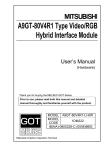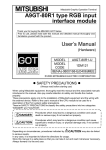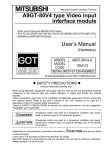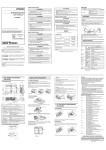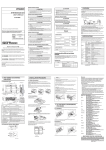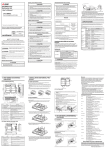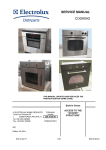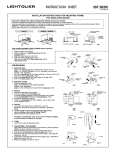Download Operating Instructions
Transcript
Operating Instructions for Flame-Detector Type FL 95/HT-P in Combination with Evaluation Board 19Z/HT-P4/880 Rules for mounting, starting, testing and maintenance 1. Mounting When mounting the flame detector the optical location angle of the unit has to be taken into consideration. The angle is vertical approx. 80° horizontal approx. 80° The sensitivity will decreases to the sides. Therefore adjust the flame detector directly to the project to be monitored. The flame identifikation is depending from the intensity of the flame and from the distance between the flame and the flame detector. Due to this fact the flame detector has to be mounted as close as possible to the project. For monitoring of a room the optical location angle of the detector has to be taken into consideration. If the unit will be mounted in the open air or in covered halls (petrol depot monitoring, gas stations etc.) it has to be considered that the flame of the flare of excess gas also if the flame is far away from the detector, gas and welding flames and the electric arcs of the electric welder and of electric trains can effect a release of the detector. In these cases the sensitivity adjustment has to dispute prior to mounting the unit. In room with contaminated air (dusty or greasy air) the detector has to be mounted so that it is ventilated with fresh air to avoid depositing of dust or oil on the inspection glass. Attachment dimensions: Refer to Dimension Drawing No. 3.5306.1. 2. Starting Basic: Wiring Diagram No 3.4328.1 and Description of the evaluation board 19Z/HT-P4/880 and the Connection Diagram No 3.5306.2 of the detector. Connect the flame detector with the evaluation board according to the terminal Numbers. Prior to switching on the unit check the 24 VDC power supply, the connections to the detector and the connections of the signal outputs on the evaluation board. Voltage and Temperature Monitoring During the failure-free operation the relays K2 and K3 for the temperature monitoring gets energized, according to the closed-circuit principle. Testing/Fire Alarm Signal Flame detectors mounted in explosion hazard areas may only be tested by use of an explosion-proof UV-tester. Outside of these areas testing can be carried out by an open flame (match, lighter etc.). The flame shall be directed to the detector to be tested. Thereby the time until the alarm gets on the depending from a) the contamination of the optic of the detector (if necessary clean before testing, refer to maintenance and test instructions), Date : 09/2000 Version: 0 4.5306.6-1 Page 1 of 3 b) the sensitivity adjusted on the evaluation board, c) the minimum time of response adjusted of the evaluation board (time-delayed alarm), d) proper function of the detector and evaluation board. In case of fire alarm the relay K1 will be actuated according to the adjusted type of alarm, and the red LED "Fire" lights up. Continuous Alarm A continuous alarm signal can be reset by shortly disconnection of the 24 VDC supply (+24 VDC), or by actuating of the push button switch of the evaluation board (position "OFF"), or by short connection of pin 10a of the evaluation board to earth potential. Time-Limited Alarm This alarm will be effected corresponding to the adjusted time of alarm, and will be repeated as long as the source (tester of fire) will be detected. Test by use the Test Device installed in the Flame Detector Connect +24 VDC to the corresponding input of the flame detector. Detection of the UV-radiation and release of the alarm will be effected as described under "Fire Alarm Signal". If the detector does not release "Fire Alarm" within 10 to 15 seconds (at normal adjusted response sensitivity), is this a sign that a failure is present. At certain circumstances a low detected UV-radiation of the UV-emitter detected from the UV-detector tube can cause a release of the failure counter on the evaluation board and with this it can cause an alarm. Temperature Monitoring The temperature switch TSC 188 can be checked only outside of explosion hazard areas by heating or by disconnection of the cables on the evaluation board (relay K3 drops out). ATTENTION! An explosion-proof flame detector may never opened in explosion hazard areas due the danger of explosion. Pay attention during testing on the open and connected detector, because on the connections of the UV-tube and UV-emitter there is a voltage of 600 Volt. 4. Maintenance and Test Procedures a) In dusty atmosphere The inspection glass should be clean, so that at optical check the reflector and the UV-vacuum tube are visible. Otherwise clean the inspection glass by means of a soft grease-free cloth. If necessary clean the exit of light of the photoconductor cable. b) In greasy atmosphere No oil may be deposit on the inspection glass, because a thinn oil film can influence the sensitivity of the detector. Therefore clean the glass more often by means of a soft and grease-free cloth, respect clean the glass by means of a grease solvent, and clean the exit of light of the photoconductor cable and the glass for the UV-emitter. Condensed water on the glass causes only a little influence to the sensitivity of the detector. c) The UV-detector vacuum tube UVN 81HS/220p should be tested at least every 2 years and it is recommended to replace the tube every 4 years. Date : 09/2000 Version: 0 4.5306.6-1 Page 2 of 3 d) Electronic The evaluation electronic is generally maintenance-free. The DC/DC-transformer ht1 0879/220p generates the power for the UV-vacuum tube of 550 V +/- 5 % which can be checked by means of an oscilloscope (input resistance 20 MOhm)at pin 8. The AC-transformer ht2 0879 generates the power supply for the UV-emitter which can be checked by means of an oscilloscope (input resistance 20 MOhm) at pin 4. The operating voltage for the UV-emitter is 250 V Ws (ignition voltage 700 V Ws). The time of life of the V-emitter TEHT 79 is depending of the test time and test sequence andis at 1 test per hour (6 sec.) approx. 3 years. A reduction of the UV-radiation capacity or a defect at the DC/DC-transformer ht1 0879/220p or DC/AC-transformer ht2 0879 will be indicated by a longer time between test release and alarm signal or under certain conditions that the failure counter on the evaluation board will be released and with this a failure signal is given, even if the optic has been cleaned and the photoconductor cable has been adjusted correctly. e) The DC/DC- and DC/AC-transformers are generally maintenance-free. 5. Repairs etc. A defective flame detector should be generally, but during the guarantee of course, sent to the manufacturer. Never open an explosion-proof flame detector in the explosion area, due to the explosion danger! Repairs may only be carried out from persons who are conversant with the rules for explosion areas! Be careful at tests on the opened and connected detector, because the terminals for the UV-vacuum tube and the DC/DC-tansformer ht1 0879 /220p and DC/AC-tansformer ht2 0879 have a voltage of approx. 600 V! Repairs can be carried out by the customer and should be limited to the replacement of the following components: a) UV-detection vacuum tube UVN 81HS/220p When replace the tube take care that the red point of the tube corresponds with the red point of the socket. b) UV-emitter TEHT 79 When replace take care that the silicon ring after screwing tight of the inspection glass are sealed. c) DC/DC-tansformer ht1 0879/220p When replace take care that the cables are connected correctly especially the cables for the UV-detection vacuum tube (red point on the board). Refer diagrams No. 3.5306.2 d) DC/AC-transformer ht2 0879 When replace take care that the cables are connected correctly. e) Temperature Switch TSC 188 f) Electronic board ht3 0486 When replace take care that the cables are connected correctly. Prior to repair the unit must be switched dead. The screws of the cover must be loosened and removed. The fiber-optic cable to desmount then. After carrying out the repair make a functional check. Sealing edges and surfaces of the cover should be grease by means of not easy inflammable grease before screwing tight. Clean inspection glass from oil and dust and check detector with UV-emitter or a flame for proper function. Date : 09/2000 Version: 0 4.5306.6-1 Page 3 of 3




